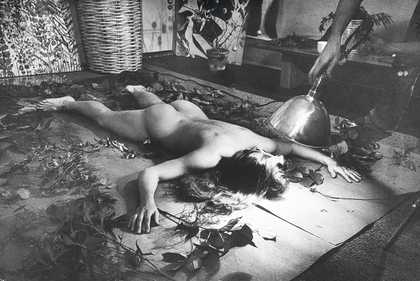In October 1948 Robert Rauschenberg enrolled at Black Mountain College, North Carolina. He studied with Josef Albers and learned from his Werklehre teaching method – the practice Albers had developed at the Bauhaus which emphasised “a fingertip feel for materials”. It was here that Rauschenberg’s pivotal early engagement with photography began under the tutelage of figures such as Hazel Larsen Archer and Aaron Siskind, and where he began taking photographs alongside his fellow students Dorothea Rockburne, Cy Twombly and Susan Weil. The experience had such an effect on him that for a time he was unsure whether to pursue painting or photography as a career. It is, then, somewhat ironic that subsequent works such as his Silk-Screen paintings were able to combine both.

Robert Rauschenberg creating a blueprint photogram, photographed by Wallace Kirkland, 1951
© Time & life Images/Getty Images
In 1949 Weil introduced Rauschenberg to the method of exposing photosensitive blueprint paper to light in order to create cameraless photographs. Untitled 1951 is among the first of their exceptionally beautiful blueprints, or blue photograms. Here, the actual one-to-one scale of these objects and bodies silhouetted against a blue background directly places the sitter in their environment, whether it be Weil’s hands clutching branches and twigs, the feet and foliage, or the human figures contorting, posing and stretching their bodies into a variety of positions that fill the edges of the paper. This photographic enlargement and faithful translation of one-to-one scale echoed Rauschenberg’s unrealised plan to deploy the medium of photography to “walk across the United States and photograph it inch by inch in actual size”.
On 9 April 1951 a three-page article in Life magazine titled “Speaking of Pictures” appeared, documenting Rauschenberg and Weil making blueprints, many of which no longer exist. The following month, their Blueprint: Photogram for Mural Decoration (now titled Female Figure) c.1950 was shown in the exhibition ‘Abstraction in Photography’ at the Museum of Modern Art, New York, organised by Edward Steichen. Discussing these “vaporous fantasies”, including one called Surreal Dancer, Life stated how the works were made using “oddments salvaged from a florist shop”.
Of course, cameraless photography was nothing new, stretching back as it does to William Henry Fox Talbot, who in the mid-nineteenth century began to use photographic paper to make negativeless works he collectively called Pencil of Nature. The technique was then revivified in the vein of the cameraless photographs of Alvin Langdon Coburn, Christian Schad and later Man Ray’s rayographs and László Moholy-Nagy’s photograms.
After his studies at Black Mountain, although Rauschenberg did not dedicate himself to the photographic medium exclusively (or, indeed, confine himself to any one particular metier), nor did he leave it behind him.
In fact, photography (whether it be in the guise of appropriated imagery from the mass-media, found photographs, or the artist’s own photographs and family snapshots) became an integral part of the Combines 1954–64, his transfer drawings and the serigraphed images from the Silk-Screen paintings 1962–64, and continued to proliferate through the Spreads and Scales series 1975–82 and 1977–81 to his final series, the Runts 2007–8.
